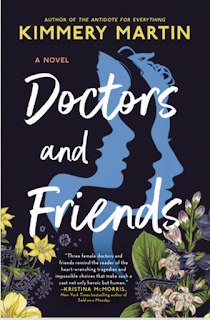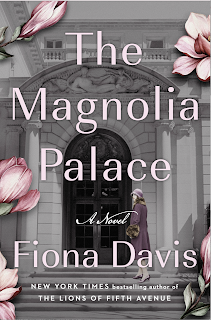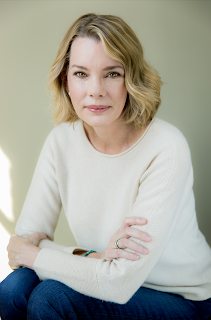Note the sublime photo above, of Audrey Munson. the first supermodel who was named "Miss Manhattan." The perfect icon for a blog about Fiona!
I adore Fiona Davis. Not just her books, either. I'm not sure when we met, but I keep happily running into her at books events (or I did, pre-pandemic, and every time I do, I get a glow. She is the New York Times bestselling author of six historical fiction novels set in iconic New York City buildings, including The Dollhouse, The Address, and The Lions of Fifth Avenue, which was a Good Morning America book club pick. Her novels have been chosen as “One Book, One Community” reads and her articles have appeared in publications like The Wall Street Journal and O the Oprah magazine. She first came to New York City as an actress, but fell in love with writing, and we are all so happy she did.
Her newest masterwork, The Magnolia Palace is about lies, betrayals and even murder in the gilded age mansion. It's got starred raves from Kirkus, Library Journal and from Publisher's weekly, and a slew of raves from the likes of Christina Baker Kline and Lisa Wingate.
Welcome Fiona! I just wish this was in person!
I always believe that writers are somehow obsessed into writing the books they write. What was haunting you that created this wonderful book?
I’ve always loved wandering around old buildings and wondering about the people who lived there over the years, so writing about iconic landmarks really fuels my obsession. The Frick Collection was built in 1914 as a residence, and then turned into a museum in the thirties. As a museum, it feels like it’s been frozen in time, with splendid furnishings everywhere and art by masters like Rembrandt, Turner, and Vermeer hanging on every wall. When you walk in, it’s as if the Frick family is out at a dinner party and will be back at any moment.
I love that you set your novels in these fabulous New York Buildings! I always feel that buildings have their own personalities, almost something you can feel when you go inside. Do you walk into these great buildings and just inhale the atmosphere and then ideas perk? And can you tell us what building is next?
The building definitely becomes like another character in the story, with its history and layout impacting the plot. During my behind-the-scenes tour of the Frick, I discovered there’s a circa 1914 bowling alley in the basement – which still works – and of course had to include that as a scene location. As I wandered the rooms I definitely began to imagine ideas for scenes and characters. For example, what was it like for a member of the household staff who lived on the top floor, with that splendid view of Central Park? As for the next book, I have a short story being published this summer that’s set at Carnegie Hall, and then the next novel is set at Radio City Music Hall, from the point of view of a Rockette in the 1950s. There are so many possibilities in New York City!
There’s so much wonderful material in this book, from the Spanish Flu to the Frick Mansion/Museum. (I love the Frick and imagine you went to visit and visit and visit again.) What was your research like?
Because the world went into lockdown a couple of months into my research, I wasn’t able to get back inside after my initial tour – and in fact now it’s closed for renovations (although the works of art are brilliantly exhibited at the Frick Madison nearby). Luckily, at the Frick’s website (frick.org), there’s a floor plan with a 360-degree view of all of the public rooms. So I virtually visited multiple times a day as I was writing the drafts. Research for this book involved going through the Frick archives, which had fun surprises like dinner party menus from 1915, or payroll records of the staff, as well as interviewing experts in the art world.
I loved your female characters, as I always do, Veronica Weber and Lillian Carter. So here is a writerly question. How did you go about developing those women? And what parts of you are in your characters? And what parts of them do you wish you had?
Veronica and Lillian are both models in different time periods – Lillian in the 1910s and Veronica in the 1960s, so it was really fun to figure out how that particular career had changed over time – and also the ways in which it hadn’t. I wish I was more of a free-spirit like Lillian, who is willing to take huge risks and throw herself into life. I’m afraid that’s just not my style. Veronica is probably a little more like me: slightly overwhelmed in a crowd and happy to watch the action from the sidelines.
And another writerly question. Using a dual timeline nearly killed me! Any tips, because you did it beautifully.
Dual timelines can be an absolute beast, no question. I figure out the plot and outline it fairly thoroughly before I sit down to write that first draft. There’s so much to keep track of, especially with an element of mystery and clues that need to be dropped at the exact right time. Once that outline is firm, I tend to write the older timeline first, and then the newer one. I find that’s easier than bouncing back and forth, which will ultimately be the way the reader views it.
What’s obsessing you now and why? What question didn’t I ask that I should have?
These days I’m obsessed with the novel The Ballerinas, by Rachel Kapelke-Dale, which is set in Paris at the ballet, and is beautifully written and a great mystery as well. And I think you covered all the bases! Thank you for this amazing opportunity, and I can’t wait to see you in person one of these days and give you a (gentle) hug.








